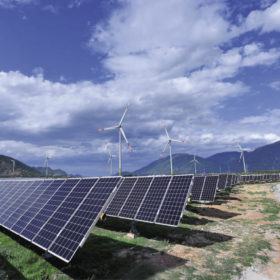
While the impact of the Covid-19 pandemic on the renewable energy market is still not clear, Norwegian consultancy Rystad Energy says that new solar and wind projects will grind to a halt in 2020, creating a ripple effect in the years to come, as currencies throughout the world continue to slide against the US dollar.
Movements in the foreign-exchange market triggered by the Covid-19 outbreak will affect all segments of the renewables market. According to Norwegian consultancy Rystad Energy, solar and wind projects will be particularly affected, as companies choose to pause development by contracting key components, which are typically procured in US dollars.
The consultancy’s grim analysis shows that plans to commission new solar and wind projects will be delayed this year and cut by an additional 10% next year. Renewables projects in Australia, Brazil, Mexico and South Africa will be particularly affected, as installations now in the procurement phase could face capital cost increases of up to 36% due to the rapid depreciation of local currencies.
Before the coronavirus outbreak, Rystad Energy expected 140 GW of PV and 75 GW of wind capacity to be built in 2020, for a year-on-year increase of 15% and 6%, respectively. However, these projects will now be delayed due to government restrictions on movement that will affect construction time frames.
Rystad Energy expects the impact of the coronavirus to be felt even more acutely from 2021, when the reduction of financial investments and the strengthening of the US dollar will reduce commissioned project capacity by at least 20 GW.
“The foreign-exchange impact will decimate the 2021 outlook for solar installations and the outlook from 2022 and beyond for wind installations, as orders for new equipment will halt from currency-hit emerging countries, which would otherwise account for much of this growth,“ said Gero Farruggio, Rystad Energy’s product manager for renewables.
Supply, demand
Since the onset of the Covid-19 outbreak, mixed reports have emerged about the impact on the global solar market. While PV manufacturing operations are now beginning to return to normal in China, questions remain about the impact on demand.
Analysts from BloombergNEF, PV InfoLink, and IHS Markit say that a significant contraction of demand is likely this year. However, some companies have reported record sales, with consumers reportedly panic-buying solar and storage equipment to shore themselves up in uncertain times.
Deadlines have been relaxed for projects that are still in the construction phase, as developers in some countries have reported that PV development is now at a complete standstill. The French and German governments, for example, have responded to complaints from solar developers by adjusting tender schemes and considering measures to avoid financial penalties and the loss of incentives due to missed deadlines.
Australia’s PV pipeline
According to Rystad Energy, companies that typically procure key project components in US dollars and reap revenue in local currencies may already feel the sting. Utility-scale wind is most at risk, as the percentage of wind development capex procured in US dollars is 25% higher than that of utility-scale PV.
“We expect macroeconomic knock-on effects will reach into 2021 and beyond, with companies pausing on procuring solar PV projects which would have been commissioned in and after 2021,” said Farruggio. “Countries most impacted in this sector will be from emerging markets in Asia, the Middle East, India and Latin America, where the bulk of solar growth had previously been expected.”
In Australia, where the dollar has hit a 17-year low, developers already appear to have cooled on orders that were otherwise imminent, the consultancy says. The country was poised for a record rollout of big PV this year and luckily much of the 2 GW of utility-scale solar expected this year has already been built. However, the country’s long-standing problem of complex grid connections will ultimately determine the cumulative amount of new PV to be connected to the grid this year.
On the other hand, projects seeking financial close will surely stop, Rystad Energy said, reducing the likelihood that the country will achieve its goal of commissioning 1.8 GW of utility-solar PV in 2021. The 1.5 GW worth of approved renewable energy projects scheduled for 2022 also face potential delays, it added.
International impact
In Latin America, Mexico and Brazil have the greatest capacity of utility-solar PV projects under construction and both are experiencing steep currency declines versus the US dollar. Rystad Energy therefore expects procurement to come to a complete halt on most, if not all, projects that have yet to be commissioned. Projects penciled in for commissioning by next year could be indefinitely delayed.
India will not be affected as much as other regions facing depreciation. Rystad Energy had previously estimated that the country would install 5.8 GW of utility-solar PV projects in 2020 and 9.9 GW in 2021.
In Europe, meanwhile, Rystad Energy initially expected more than 20 GW of solar capacity before the crisis. With the euro now sliding against the US dollar, the consultancy says foreign-exchange issues for projects in Europe are not an immediate concern, but could become a problem if the euro falls further.
China and the United States will be the least affected by forex fluctuations, and Rystad Energy expects the number of solar installations in the two countries to remain fairly stable. “Nevertheless, they will undoubtedly feel some slowdown effect, casting doubt on China’s ability to increase its solar capacity by 40 GW as initially forecasted,” it said.
Lắp đặt điện mặt trời Khải Minh Tech
https://ift.tt/2X7bF6x
0906633505
info.khaiminhtech@gmail.com
80/39 Trần Quang Diệu, Phường 14, Quận 3
Lắp đặt điện mặt trời Khải Minh Tech
https://ift.tt/2ZH4TRU
Không có nhận xét nào:
Đăng nhận xét